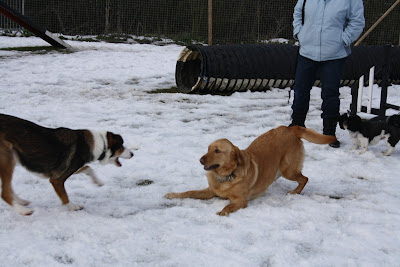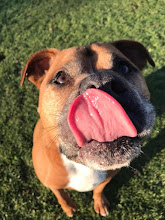DTCE - How we fix problem dogs part 3
When you introduce your dog to a muzzle it should always be a nice thing for your dog never a punishment. If you haven’t used one before you could try dabbing a small amount of cream cheese, peanut butter etc on the inside and hold it for your dog, you should find they put their own noses into it, all you need to do is add praise.
You can transfer this type of handling to the street. When your dog sees another dog and shows aggression, put him into a sit.
The reason for doing all of this is to promote yourself in the pack so that you become the pack leader.
If you are in charge its your job to be aggressive, I don’t know you; but I suspect you won’t be aggressive, so neither will your dog. Get the sit right and your dog will then start to follow your rules.
Tips:- If your dog sits next to you but puts its paw in front of your foot or on your foot, it is telling you its in charge (most aggressive dogs will do this). Move the dog back into heel and make sure their foot isn’t in front of yours. Never take them in a circle around and back into heel, because when you walk them in front of you they could quite easily think they are being promoted in the pack.
Try not to talk nicely to your dog to calm it down I’ve found this to enhance the worst fault as it praises the aggression into the dog.
Once you have your dog sitting on a loose lead as other dogs walk past; start teaching him to walk to heel. If the dog starts to show aggression again; go back to the sit.
Watch me – A lot of trainers will suggest you teach your dog to do this to help stop aggressive behaviour; this only works when the dog wants to watch you (or food) more than he wants to watch the other dog, correcting him for staring at another dog doesn’t work because in the dogs mind he’s doing his job – He probably thinks you are interfering and that means he has to try harder to prove to the other dog that he’s in charge and is more likely to show aggression.
Muzzles are a great enabler – I find that most dogs learn to get on if they are given the chance to socialize with each other. We couldn’t do this unless the dogs were ‘safe’.
So, here we have the Catch22; you need to socialize your dog to make him better, however, you can’t socialize him until he’s better.
The advantage we have is the training class. Everyone that comes to it has a similar problem with their dog, so they don’t have a problem letting them off lead together. It’s worth mentioning now that although we let dogs off lead together, the off lead part doesn’t happen until the handlers begin to gain some control over their dogs.
As I mentioned earlier, giving your dog something else to do when its being aggressive will promote you in the pack, it also means you can praise your dog for something instead of just correcting it for misbehaving. Sit is the easiest thing to try – keep it simple.
Take the dog to the park but take him training not for a walk or exercise; this is an important point because you will go out with a different attitude and this will produce a much calmer walk..







